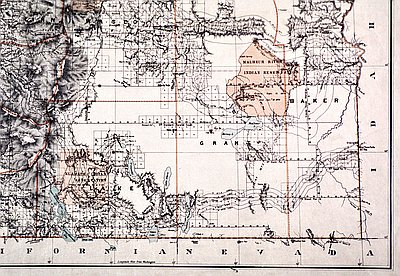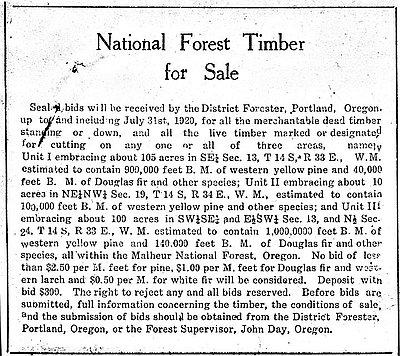- Catalog No. —
- Mss 736
- Date —
- August 14, 1920
- Era —
- 1881-1920 (Industrialization and Progressive Reform)
- Themes —
- Environment and Natural Resources, Government, Law, and Politics
- Credits —
- Oregon Historical Society
- Regions —
- Northeast
- Author —
- Eastern Oregon Land Co
National Forest Timber for Sale
These documents describe an early timber sale in the Malheur National Forest. The first document is a newspaper advertisement for the sale, which took place in the summer of 1920. The second document is a letter from an agent of the Eastern Oregon Land Company providing information on who the buyers were and what they planned to do with the timber.
Most of the national forests in the Pacific Northwest were established in the 1890s and 1900s, but most timber supplies came from private lands until after World War I. The war created a massive demand for timber products. By the time the war ended in 1918, many private timber operators had cut most of the prime timber from their own lands and began looking toward the national forests for additional supplies.
The Forest Service was eager to meet the growing demand. They started ramping up sales in the early 1920s, particularly in the national forests of the inland Northwest. At this time many forest scientists believed that old-growth forests were “decadent and overmature” because of their slow growth rate. They believed that an increase in overall timber production could be achieved by replacing old-growth forests with "regulated forests," that is, younger, faster growing stands that could be scientifically managed to maximize production.
The first step in the creation of these regulated forests in the Blue Mountains was the liquidation of old-growth ponderosa pine forests, a practice that began in earnest in the 1920s. By 1929 harvests of ponderosa pine in eastern Oregon and Washington were almost 1.5 billion board-feet annually, up from approximately 400 million fifteen years earlier. Environmental historian Nancy Langston notes that in the Forest Service’s “haste to regulate the Blues forests, planners authorized extremely rapid harvests, well knowing that those harvests would ensure the collapse of the local timber industry by the 1990s.”
Indeed, harvests in the Blues declined dramatically in the 1990s. This was due in part to unsustainable harvest levels in previous decades, but there was also a growing recognition of a serious forest health crisis. In many areas of the Blues ponderosa pine and mixed conifer forests have been replaced by dense stands of Douglas fir and true fir of negligible commercial value. These stands are often subject to catastrophic fire, disease outbreaks, and insect infestations. Many researchers have traced the origin of this forest health crisis to forest management practices initiated in the first decades of the twentieth century.
Further Reading:
Langston, Nancy. Forest Dreams, Forest Nightmares: The Paradox of Old Growth in the Inland West. Seattle, Wash., 1995.
Written by Cain Allen, © Oregon Historical Society, 2005.
Related Historical Records
-
Malheur Indian Reservation
This detail from an 1879 General Land Office map shows the Malheur Indian Reservation in southeastern Oregon. An 1872 executive order by President Ulysses S. Grant established the …

-
National Forest Timber for Sale
These documents describe an early timber sale in the Malheur National Forest. The first document is a newspaper advertisement for the sale, which took place in the summer of …

-
Restructuring the Timber Economy
In October 1979, the bottom fell out of the wood-products market. Over the next three years, lumber prices dropped by more than 48 percent. The national recession of …
